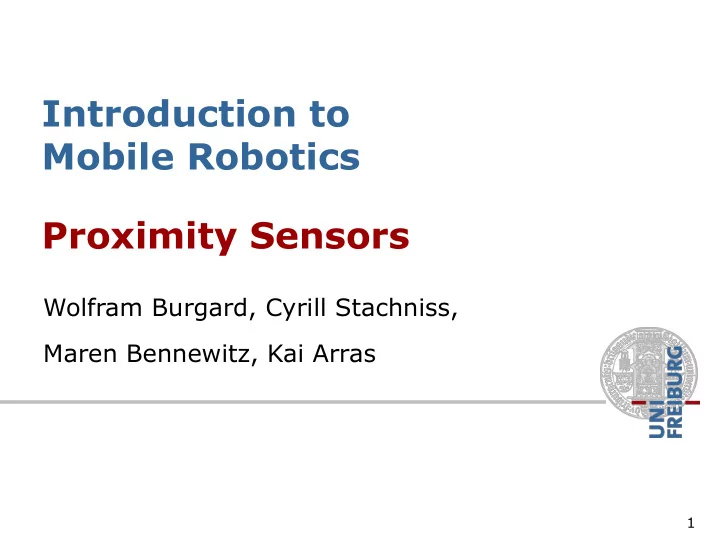

Introduction to Mobile Robotics Proximity Sensors Wolfram Burgard, Cyrill Stachniss, Maren Bennewitz, Kai Arras 1
Sensors of Wheeled Robots Perception of the environment Active: Time of flight Ultrasound Laser range finder Infrared Intensity-based Passive: Cameras Tactiles 2
Tactile Sensors Measure contact with objects Touch sensor Spring Bumper sensor Contact 3
Ultrasound Sensors Emit an ultrasound signal Wait until they receive the echo Time of flight sensor Polaroyd 6500 4
Time of Flight Sensors emitter object d v t / 2 v : speed of the signal t : time elapsed between broadcast of signal and reception of the echo. 5
Properties of Ultrasounds Signal profile [Polaroid] 6
Sources of Error Opening angle Crosstalk Specular reflection 7
Typical Ultrasound Scan 8
Parallel Operation Given a 15 degrees opening angle, 24 sensors are needed to cover the whole 360 degrees area around the robot. Let the maximum range we are interested in be 10m. The time of flight then is 2*10/330 s=0.06 s A complete scan requires 1.45 s To allow frequent updates (necessary for high speed) the sensors have to be fired in parallel. This increases the risk of crosstalk 9
Laser Range Scanner 10
Properties High precision Wide field of view Some laser scanners are security approved for emergency stops (collision detection) 11
Computing the End Points Laser data comes as an array or range readings, e.g. [1; 1.2; 1.5; 0.1; 81.9; …] Assume an field of view of 180 deg First beams starts at -½ of the fov Maximum range: ~80 m (SICK LMS) 12
Computing the End Points Laser data comes as an array or range readings, e.g. [1; 1.2; 1.5; 0.1; 91.9; …] Assume an field of view of 180 deg First beams starts at -½ of the fov Blackboard: Where are the end points relative to the sensor location? Where are the end points in an external coordinate system? 13
Robots Equipped with Laser Scanners 14
Typical Scans 15
Recommend
More recommend